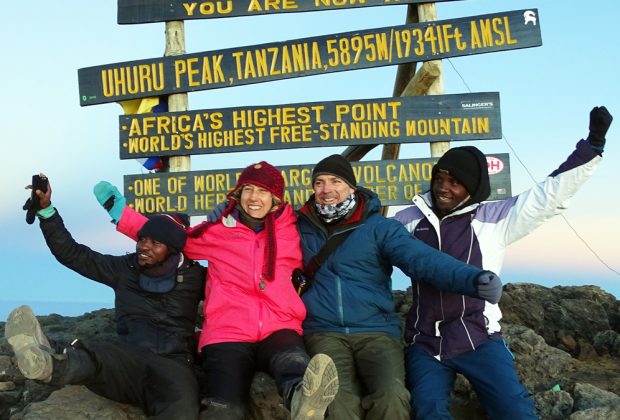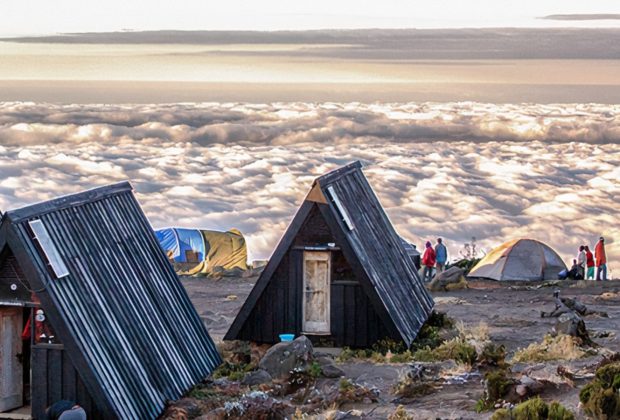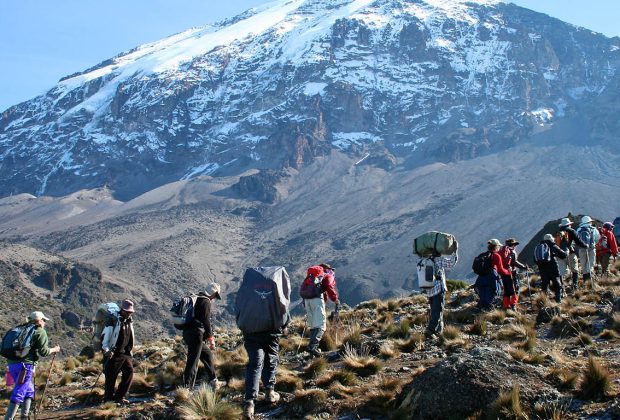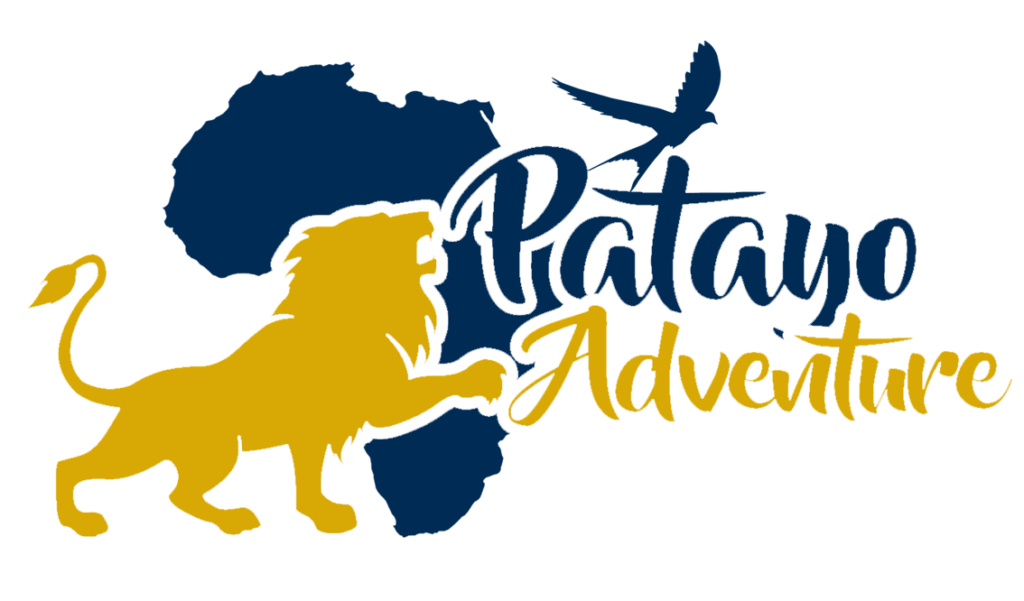6-Day Kilimanjaro Trekking Via Machame Route + 2 Nights Hotel Stay
Tour Overview
The Machame Route offers a diverse landscape and breathtaking views, providing a unique opportunity to test your determination, physical fitness, and mental resilience. This route takes you through lush rainforests inhabited by colobus monkeys, then transitions into heath and moorland adorned with ferns and ericas, before culminating at the icy summit of the mountain. With its varying altitudes and a bit of luck, the Machame Route provides an ideal environment for acclimatization, increasing your chances of successfully reaching the summit. Overnight accommodations along this route are in tents.



DAY 1: ARRIVAL
Upon arrival at Kilimanjaro International Airport (JRO), you’ll be greeted by a representative from Kiliholidays. They’ll escort you to Weru Weru River Lodge or similar accommodation. The lodge offers all the comforts for a pleasant stay: cozy rooms, hot water, friendly staff, a swimming pool, and Internet access. In the evening, there will be a briefing by our managers to ensure you’re prepared for the climb.
- BED & BREAKFAST Note: Check-in begins at 1:00 PM.
DAY 2: TREKKING FROM MARANGU GATE TO MANDARA HUT
Your guide and mountain support crew will meet you at the hotel in the morning for a quick briefing. Then, you’ll travel by vehicle to Kilimanjaro National Park’s eastern entrance: Marangu Gate (1,860 m). After obtaining climbing permits and registering with the search and rescue service, the group will trek to Mandara Hut (2,700m). The trail passes through rainforest, so bring spare clothes and raincoats. Upon reaching the camp, the support crew will handle setup and lunch. You’ll spend the night in special huts along the Marangu route. It’s your first day at altitude, so follow instructions carefully.
- LUNCHEON;
- DINNER ELEVATION: 1,860 m to 2,700 m
- HIKING TIME: 5-7 hours
- DISTANCE: 11 km
- DIFFICULTY: Medium
- HABITAT: Rainforest
- DAY 3: TREKKING FROM MANDARA HUT TO HOROMBO HUT
After breakfast, depart Mandara Hut for a moderate trek to Horombo Hut (3,720 m). En route, enjoy views of Kibo and Mawenzi volcanoes. After lunch, complete an acclimatization hike towards Kibo Hut before returning to Horombo Hut for dinner. Note: Acclimatization hikes are crucial for summit success and altitude sickness prevention.
- BREAKFAST;
- LUNCH;
- DINNER ACCLIMATIZATION HIKE: Change in Elevation: Horombo Hut (3,720 m) — Destination point in route to Kibo Hut (3,920 m)
- HIKING DISTANCE: 2.5 km
- HIKING TIME: 1–2 hours
- ELEVATION: 2,700 m to 3,720 m
- HIKING TIME: 5-6 hours DISTANCE: 10 km
- DIFFICULTY: Medium
- HABITAT: Moorland
DAY 4: TREKKING FROM HOROMBO HUT TO KIBO HUT
After breakfast, trek to Kibo Hut (4,700 m). It’s not a difficult trek, but maintain an appropriate pace for the summit push. After lunch, rest, avoid strenuous activity, and hydrate.
- BREAKFAST;
- LUNCH;
- DINNER
- ELEVATION: 3,720 m to 4,700 m
- HIKING TIME: 4-8 hours
- DISTANCE: 10 km
- DIFFICULTY: High
- HABITAT: Alpine desert
DAY 5: TREKKING TO UHURU PEAK AND DESCENT TO HOROMBO HUT
Depart Kibo Hut for the trek to Uhuru Peak (5,895 m). It’s physically moderate but altitude is a challenge. Each pair of climbers will have their own guide. After reaching Uhuru Peak, descend to Kibo Camp, rest, then continue to Horombo Hut. Note: Most accidents occur during descent; pay attention to your feet.
- BREAKFAST;
- LUNCH;
- DINNER ELEVATION: 4,700 m to 5,895 m to 3,720 m
- HIKING TIME: 8-12 hours
- DISTANCE: 15 km DIFFICULTY: High
- HABITAT: Arctic
DAY 6: DESCENT FROM HOROMBO HUT TO MARANGU GATE
After breakfast, begin your descent from Horombo Hut to Marangu Gate (1,860 m). The trek will take you through the stunning landscapes you’ve experienced on your ascent. Take your time to appreciate the beauty of the surroundings as you make your way down. Upon reaching Marangu Gate, you’ll complete some formalities with park authorities before bidding farewell to your guides and support crew. A transfer will be arranged to take you back to Weru Weru River Lodge or similar accommodation, where you can relax and reflect on your incredible journey.
- BREAKFAST;
- LUNCH ELEVATION: 3,720 m to 1,860 m
- HIKING TIME: 5-6 hours
- DISTANCE: 20 km
- DIFFICULTY: Medium
- HABITAT: Moorland, Rainforest
Inclusions:
- Accommodation: Lodging at Weru Weru River Lodge or similar.
- Meals: Breakfast, lunch, and dinner provided during the trek.
- Transportation: Transfer from Kilimanjaro International Airport to the lodge.
- Trekking Support: Experienced guide and mountain support crew.
- Climbing Permits: Acquisition of necessary permits for Kilimanjaro National Park.
- Equipment: Tents, sleeping bags, and other necessary camping gear.
- Activities: Trekking from Marangu Gate to Mandara Hut, Mandara Hut to Horombo Hut, Horombo Hut to Kibo Hut, and summiting Uhuru Peak.
- Briefings: Orientation and briefing sessions conducted by tour managers.
- Safety Measures: Registration with search and rescue service, as well as guidance on altitude sickness prevention.
- Certificates: Commemorative certificates upon successful completion of the trek.
Exclusions:
- International Flights: Airfare to and from Kilimanjaro International Airport.
- Travel Insurance: Personal travel insurance covering medical expenses, trip cancellations, and emergencies.
- Personal Expenses: Expenses for additional meals, beverages, souvenirs, and optional activities.
- Gratuities: Tips for guides, porters, and other staff members.
- Accommodation Beyond Itinerary: Any additional lodging required before or after the scheduled trekking dates.
- Airport Transfers: Transfers to the airport upon departure beyond the designated schedule.
- Visa Fees: Fees associated with obtaining entry visas for Tanzania, if applicable.
- Medical Expenses: Costs incurred for medical treatment or medications during the trek.
- Optional Activities: Any additional excursions or activities not specified in the itinerary.
What is Mount Kilimanjaro?
- Mount Kilimanjaro is the highest peak in Africa, located in Tanzania. It is a dormant volcano and one of the most iconic mountains in the world.
How tall is Mount Kilimanjaro?
- The summit of Mount Kilimanjaro, called Uhuru Peak, stands at an elevation of 5,895 meters (19,341 feet) above sea level.
How long does it take to climb Mount Kilimanjaro?
- The duration of a Kilimanjaro climb varies depending on the route chosen. Most climbs typically range from 5 to 9 days.
What are the different routes up Mount Kilimanjaro?
- There are several routes to the summit of Kilimanjaro, each with its own characteristics and scenery. Popular routes include the Marangu, Machame, Lemosho, Rongai, and Northern Circuit routes.
Is climbing Mount Kilimanjaro difficult?
- Climbing Kilimanjaro is challenging due to its high altitude, but it doesn’t require technical climbing skills. However, climbers should be physically fit and prepared for the rigors of high-altitude trekking.
Do I need a guide to climb Mount Kilimanjaro?
- Yes, it is mandatory to have a registered guide accompany you on your Kilimanjaro climb. Guides are essential for safety, navigation, and providing support throughout the trek.
When is the best time to climb Mount Kilimanjaro?
- The best times for climbing Kilimanjaro are during the dry seasons, which are typically from late June to October and from December to March. These months offer clearer skies and better trekking conditions.
What should I pack for climbing Mount Kilimanjaro?
- Essential items for climbing Kilimanjaro include proper clothing for varying temperatures, sturdy hiking boots, a good quality sleeping bag, trekking poles, personal medications, and other necessary gear as recommended by your tour operator.
What are the risks of climbing Mount Kilimanjaro?
- The main risks of climbing Kilimanjaro include altitude sickness, which can affect anyone regardless of fitness level, as well as other potential hazards such as extreme weather conditions and physical exhaustion.
Do I need to train before climbing Mount Kilimanjaro?
- Yes, it is highly recommended to undergo physical training and preparation before attempting to climb Kilimanjaro. This can include cardiovascular exercises, strength training, and hiking to build endurance and fitness levels.
